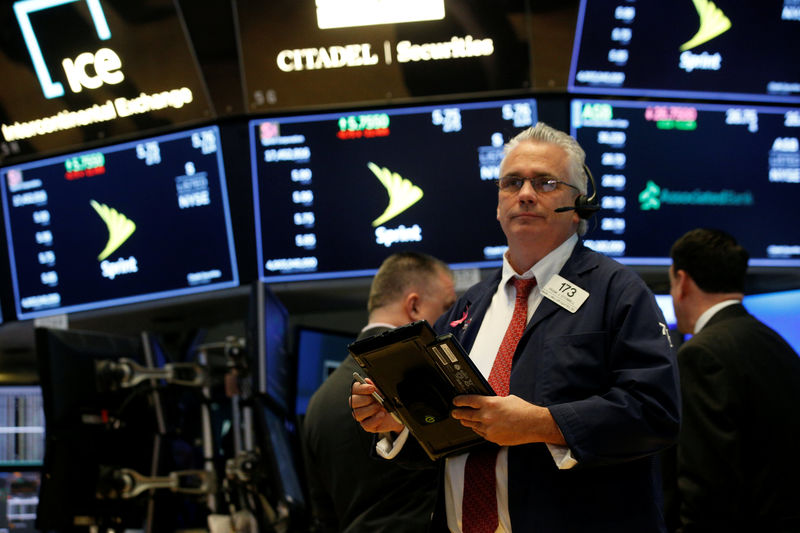By Saqib Iqbal Ahmed
NEW YORK (Reuters) - The February volatility shock may be receding in the U.S. stock markets' rear-view mirror, but it has dramatically altered VIX-land - the market where traders place bets on volatility via products linked to the VIX, the stock market's so-called "fear gauge."
U.S. equity investors spent 2017 cocooned in one of the most tranquil periods in history, with some investors selling volatility via VIX-linked products to pad returns.
The first real spike in volatility in years threw these products into disarray. Some were terminated. Others saw their heft diminished. Overall trading in VIX products fell sharply.
It "feels lame," said Matt Thompson, co-head of Typhon Capital LLC's volatility group in Chicago, who actively trades VIX futures, options and VIX-linked exchange traded products (ETPs). "Like all the air has been sucked out."
Over the last month, average daily trading volume in first- and second-month VIX futures, the most active VIX contracts, slumped by nearly a quarter from the six months ahead of February's spike. VIX options volume is down 29 percent.
"There definitely seems to have been, like, this line between pre- and post-February 5," said Thompson.
Growing interest in trading in volatility in recent years gave birth to more than two dozen volatility-linked ETPs aiming to provide exposure to stock market swings. They provided a big boost to VIX futures trading.
Some ETPs were long volatility, gaining in choppier markets, while a clutch of inverse-VIX products benefited from calm.
Since these products either directly held VIX futures or used them for hedging, they boosted open interest, said Vance Harwood, who runs the alternative investment website Six Figure Investing and has studied VIX ETPs extensively.
In 2017, U.S. stock market volatility fell to a five-decade low and yield-seeking investors rushed to sell insurance against stock market turmoil as a way to boost returns.
This was particularly evident in the short VIX-linked products. Assets under management at two of the largest of these, the VelocityShares Daily Inverse VIX Short-Term ETN
THE CHANGING VOL-SCAPE
Traditionally, buy-side positioning in VIX futures had been shaped by investors betting on where volatility would be in future months. The rush of money into XIV and SVXY changed that.
"There was a misunderstanding in the market that trading in XIV and SVXY was because people wanted to be short volatility," said Stuart John Barton, portfolio manager at Invest In Vol, an investment adviser in Stamford, Connecticut.
In truth, lots of investors were short volatility just to pocket the gain from selling financial insurance, Barton said.
Lincoln Edwards, head of Austin-based Houndstooth Capital Management, likened it to selling insurance on beach-front property. It is easy money as long as conditions remain calm.
"The average Joe saw there's money to be made in this, didn't fully understand the risks and started selling insurance. A hurricane came along and now they are out of business," he said.
The "hurricane" hit Feb. 5 when U.S. stocks fell 4 percent and the VIX rocketed 20.01 points, its largest one-day move ever.
Given the VIX's low level beforehand, the percentage gain in the futures was huge - 96 percent. That torpedoed the short-VIX ETPs, which lost nearly all their value in a day, a fate they'd dodged during the VIX's previous big upheaval in 2015 because the index was not nearly so low ahead of time.
The XIV was terminated and the SVXY cut its daily-move parameter from a 1-to-1 inverse relationship with VIX futures to a 1-to-2 target. The number of open VIX futures contracts has plunged 43 percent from late January.
"It absolutely changed the way I think about the space," said Houndstooth's Edwards. "You don't have that market force out there balancing and putting pressure on the short side."
The net position for asset managers or institutional players, leveraged funds and other traders, who together are described as the 'buy-side,' has swung to a net long 47,969 contracts, according to U.S. Commodity Futures Trading Commission positioning data through April 24.
While that is down from the record high of 73,351 contracts the week before, these players had been net short 21,613 contracts ahead of February's upheaval.

"That market force that has driven volatility for a long period of time has disappeared almost entirely," said Stefan Wintner, vice president, Volatility Strategies at Dunn Capital Management.